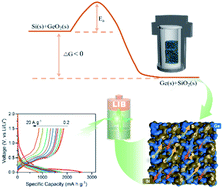Silicothermic reduction reaction for fabricating interconnected Si–Ge nanocrystals with fast and stable Li-storage†
Abstract
An innovative and controllable silicothermic reduction is developed to prepare Si–Ge nanocrystals with the assistance of molten ZnCl2 at 450 °C, in which excess Si is explored as both the reductant and part of the target product, and a molten-salt medium can lower the reaction temperature. In situ reduction of GeO2 occurring on Si particles ensures the tight and uniform contact of residual Si and resulting Ge, forming an interconnected framework. The molar ratio of Si in all nanocrystals can be well controlled by varying the initial reactants. As the anode materials for lithium-ion batteries, the optimized Si–Ge nanocrystals exhibit impressive rate capability (a capacity of 866.8 mA h g−1 at 20 A g−1) and long cycling stability (a capacity of 1046 mA h g−1 at 2 A g−1 after 500 cycles). In situ Raman spectra, CV and GITT measurements demonstrate that the interconnected binary framework with Si and Ge nanocrystals facilitates the accommodation of volume change by step-by-step fast lithiation and improvement of the kinetic process in terms of overpotential and reaction resistance assisted by a conductive Ge component. Significantly, the silicothermic reduction is extended to produce other Si-containing functional materials or alloys such as Si–Sn, Si–Sb, Si–Bi, Si–Cu–Cu3Si, and Si–C via the reduction of various oxides or carbonates. This proposed silicothermic reduction system enriches the basic discipline of synthetic chemistry.



 Please wait while we load your content...
Please wait while we load your content...